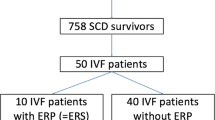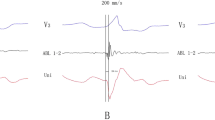Abstract
Introduction: Recent experimental and clinical trials have provided evidence that increased duration of right ventricular electrogram in response to premature extrastimuli correlates with the risk of ventricular fibrillation in noncoronary heart disease. The aim of the present study was to investigate the duration of the surface QRS complex at short coupling intervals of extrastimuli as a new indicator for major arrhythmic events.
Methods: 32 patients all with nonischemic heart diseases and well preserved left ventricular function in sinusrhythm were included into the study. Fifteen had witnessed sudden death due to ventricular fibrillation or polymorphic ventricular tachycardia (VF/VT group). The control group comprised seventeen patients without a history of ventricular arrhythmias (control group). All subjects underwent programmed ventricular stimulation and QRS-durations S1-S2-S3 directly above the ventricular refractory period were analyzed.
Results: Both groups had a comparable basic QRS complex of 85 ± 9 (VF/VT) vs. 87 ± 13 ms (control), p = 0.83. The stimulated QRS complex S3 was significantly wider in the VF/VT group compared to the control group at pacing rates of 500 and 430 ms (500 ms: 256 ± 22 vs. 235 ± 32 ms, p = 0.04; 430 ms: 258 ± 23 vs. 226 ± 27 ms, p = 0.001). No differences with regard to the ventricular effective refractory period and the ventriculoatrial conduction could be observed beween the groups.
Conclusions: Our results indicate that the duration of the paced QRS complex may be a valuable parameter to predict arrhythmic risk in patients with nonischemic heart disease. Further prospective studies in larger trials are necessary to corroborate this investigation.
Similar content being viewed by others
References
Huikuri HV, Castellanos A, Myerburg RJ. Sudden death due to cardiac arrhythmias. N Engl J Med 2001:345:1473–1482.
Myerburg RJ, Castellanos A. Cardiac arrest and sudden death. In: Braunwald E (ed.), Heart Disease: A Textbook of Cardiovascular Medicine. Philadelphia, Pa: WB Saunders. 1997:742–779.
AVID Investigators. The antiarrhythmics versus implantable defibrillators (AVID) investigators: A comparison of antiarrhythmic drug therapy with implantable defibrillators in patients resuscitated from near fatal ventricular arrhythmias. N Engl J Med 1997:337:1576–1583.
Zipes DP, Wellens HJ. Sudden cardiac death. Circulation 1998;98:2334–2351.
Engelstein ED, Zipes DP. Sudden cardiac death. In: RW, Alexander RC, Schlant and V, Fuster (eds.), The Heart, Arteries and Veins. New York. McGraw-Hill. 1998:1081–1112.
Saumarez RC, Slade AK, Grace AA, Sadoul N, Camm AJ, McKenna WJ. The significance of paced electrogram fractionation in hypertrophic cardiomyopathy. A prospective study. Circulation 1995;91:2762–2768.
Saumarez RC, Heald S, Gill J, Slade AK, de Belder M, Walczak F, Rowland E, Ward DE, Camm AJ. Primary ventricular fibrillation is associated with increaesd paced right ventricular electrogram fractionation. Circulation 1995;92:2565–2571.
Brembilla-Perrot B, Suty-Selton C, Beurrier D, et al. Differences in mechanisms and outcomes of syncope in patients with coronary disease or idiopathic left ventricular dysfunction as assessed by electrophysiologic testing. J Am Coll Cardiol 2004;44:594–601.
Saumarez RC, Chojnowska L, Derksen R, Pytkowski M, Sterlinski M, Huang CT, Sadoul N, Haver RN, Ruzyllo W, Grace AA. Sudden death in noncoronary heart disease is associated with delayed paced ventricular activation. Circulation 2003;107:2595–2600.
Turner I, L-C Huang C, Saumarez RC. Numerical simulation of paced electrogram fractionation: Relating clinical observations to changes in fibrosis and action potential duration. J Cardiovasc Electrophysiol 2005;16:151–161.
Klein RM, Schwartzkopff B, Gabbert HE, Strauer BE. Diminished coronary reserve in patients with biopsy-proven inflammatory infiltrates. Cardiology 2003;100:120–128.
Schwartz PJ, Moss AJ, Vincent GM, Crampton RS. Diagnostic criteria for the long QT syndrome. An update. Circulation 1993;88:782–784.
Brugada J, Brugada R, Brugada P. Right bundle-branch block and ST-segment elevation in leads V1 through V3: A marker for sudden death in patients without demonstrable structural heart disease. Circulation 1998;97:457–460.
Breithardt G, Cain ME, el-Sherif N, Flowers N, Hombach V, Janse M, Simson MB, Steinbeck G. Standards for analysis of ventricular late potentials using high resolution or signal-averaged electrocardiography. A statement by a Task Force Committee between the European Society of Cardiology, the American Heart Association and the American College of Cardiology. Eur Heart J 1991;12:473–480.
Anonymous. Heart rate variability: Standards of measurement, physiological interpretation and clinical use. Task Force of the European Society of Cardiology and the North American Society of Pacing and Electrophysiology. Circulation 1996;93:1043–1065.
Tracy CM, Akhtar M, DiMarco JP, Packer DL, Weitz HH. American College of Cardiology/American Heart Association clinical competence statement on invasive electrophysiology studies, catheter ablation, and cardioversion. A report of the American College of Cardiology/American Heart Association/American College of Physicians-American Society of Internal Medicine Task Force on clinical competence. J Am Coll Cardiol 2000;36:1725–1736.
Hennersdorf MG, Strauer BE. Arterial hypertension and cardiac arrhythmias. J Hypertens 2001;19:167–177.
Varnava AM, Elliott PM, Sharma S, McKenna WJ, Davis MJ. Hypertrophic cardiomyopathy: The interrelation of disarray, fibrosis, and small vessel disease. Heart 2000;84:476–482.
Schwartzkopff B, Brehm M, Mundhenke M, Strauer BE. Repair of coronary arterioles after treatment with perindopril in hypertensive heart disease. Hypertension 2000;36:220–225.
Antony J, Lerebours G, Nitenberg A. Angiotensin-converting enzyme inhibition restores flow-dependent and cold pressure test-induced dilatations in coronary arteries of hypertensive patients. Circulation 1996;94:3115–3122.
Watkins H, McKenna WJ, Thierfelder L. Mutations in the genes for cardiac troponin T and alpha-tropomyosin in hypertrophic cardiomyopathy. N Engl J Med 1995;332:1058–1064.
Marban E. Cardiac channelopathies. Nature 2002;415:213–218.
Priori SG, Napolitano C, Grillo M. Concealed arrhythmogenic syndromes: The hidden substrate of idiopathic ventricular fibrillation? Cardiovasc Res 2001;50:218–223.
de Bakker JM, van Capelle FJ, Janse MJ, Tasseron S, Vermeulen JT, de Jonge N, Lahpor JR. Fractionated electrograms in dilated cardiomyopathy: Origin and relation to abnormal conduction. J Am Coll Cardiol 1996;27:1071–1078.
Winfree AT. Mechanisms of cardiac fibrillation. Science 1995;270:1224–1225.
Author information
Authors and Affiliations
Corresponding author
Rights and permissions
About this article
Cite this article
Schueller, P.O., Hennersdorf, M.G. & Strauer, B.E. Sudden death is associated with a widened paced QRS complex in noncoronary cardiac disease. J Interv Card Electrophysiol 15, 125–130 (2006). https://doi.org/10.1007/s10840-006-8345-9
Received:
Accepted:
Issue Date:
DOI: https://doi.org/10.1007/s10840-006-8345-9




